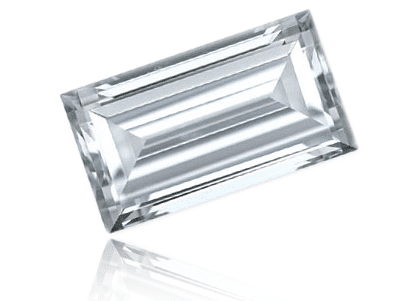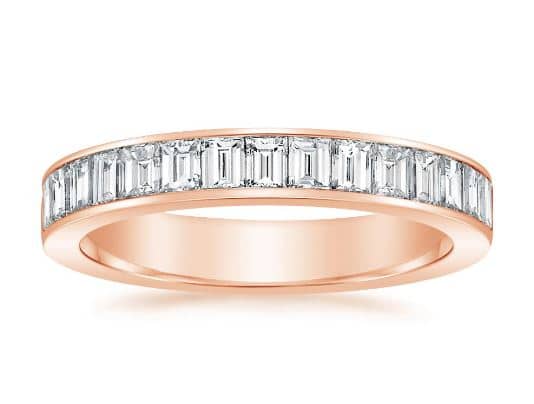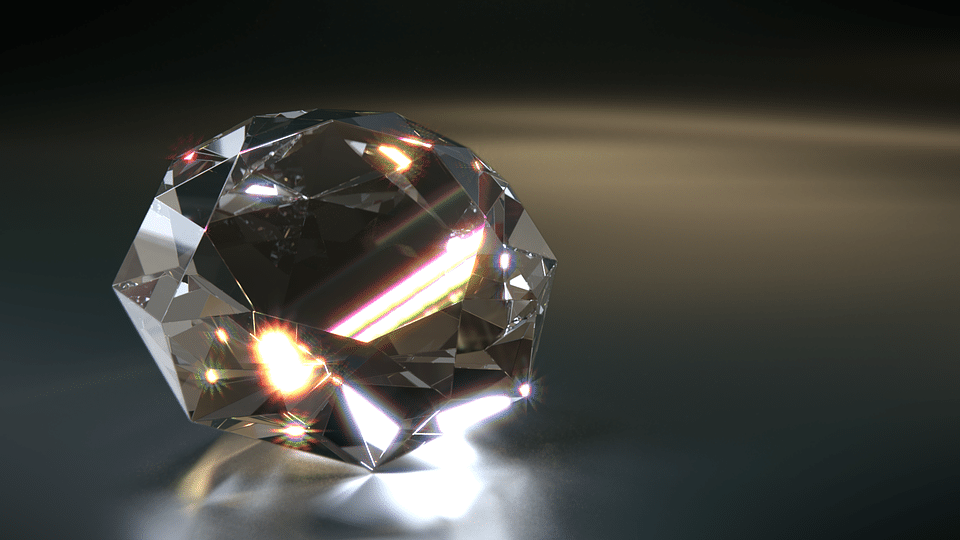Diamonds are available in many different types of cut. For a timeless standout piece, you’ll want to look for baguette cut diamonds. They have a rectangular shape but shouldn’t be mistaken for the emerald cut that is also rectangular. Below we have outlined what characteristics make the baguette cut unique. We have also touched on their history and provided a guide for buying good quality baguette cut diamonds.
What Is a Baguette Cut Diamond?

The baguette diamond is a diamond cut in a bread-like shape. Baguette diamonds go well with vintage style. They also serve well for adding opulence to an outfit. If you’re familiar with the emerald cut, you might be wondering how baguette is different. A baguette cut diamond has squared off corners, whereas emerald cut has angled corners. Sometimes, baguette cut diamonds are tapered at one end to create a trapezoid shape.
Baguette cut diamonds are a type of step cut. This means that their facets look like steps in contrast to the triangles and corners of other cuts. The long narrow facets of a baguette cut diamond resemble a house of mirrors, called prismatic reflection. Others like to call it a staircase appearance. Emerald cut and Asscher cut diamonds are also step cuts, so sometimes they are mistaken as baguette.
Brilliance and Sparkle
As with all step cut diamonds, baguette cut gems have less brilliance than round cut diamonds. Baguette cut diamonds also have less sparkle than other cuts. If a diamond has flaws, they are more noticeable if a baguette cut is used. Because of having less brilliance, poor color grades are more noticeable in a baguette cut diamond. Total depth doesn’t matter for baguette diamonds because they’re not created for brilliance.
Facets
Another key difference between emerald and baguette cut diamonds is the number of facets. Baguette has 14 facets in contrast to emerald’s 50-58.
Types
Two types of baguette cuts are straight and tapered. Straight baguette cut diamonds are perfectly rectangular. Their opposing sides are perpendicular to each other. Tapered baguette diamonds are those with a trapezoidal shape. They are narrower on one of their ends.
Weight
A lot of baguette cut diamonds are under one carat in weight because they’re commonly used as accents. They are less expensive than diamonds of other cuts, including round and emerald.
History of Baguette Cut Diamonds

Baguette cut diamonds date back to the 16th century. This type of cut stemmed from the hogback cut. Terminology has simply changed over the years. In the 20th century, people started calling it baguette cut. Because geometric patterns and streamlined forms became popular during the Art Deco period, baguette cut diamonds increased in popularity.
“Baguette” is a French word that means a long, thin loaf of French bread. A baguette cut diamond is similar in shape. Originally, people liked baguette cut diamonds for their functionality. In the Art Deco and Art Nuevo period, non-conformists valued the baguette cut diamond because it was different from the traditional round cut. Many people who bought baguette cut diamond jewelry at that time viewed it as a way to show individuality.
Western society in general was welcoming of the baguette cut diamond in jewelry. Another factor that played a role in baguette cut diamonds becoming popular is their light weight and fewer cuts. Because they take fewer cuts, each cut counts more. Virtually all baguette cut diamonds in jewelry have excellent cut quality as a result. Jewelers and manufacturers think poor quality cut baguette isn’t suitable for use in jewelry.
Buying Guidelines

Brilliance and sparkle aren’t important factors in buying baguette diamonds. They aren’t cut to maximize brilliance and sparkle like some other cuts are. Typically, baguette gems are most suitable when paired with emerald cut or Asscher cut diamonds. But you have other options too. When you’re buying jewelry that has baguette diamonds as side stones, they should be equivalent to the center stone in color grade. If the center stone is a brilliant princess cut, then it may appear whiter than the side stones. In that case, you should search for baguettes of a higher color grade than the centerpiece.
Clarity is an important factor in buying baguette diamonds. They should at least be eye clean, meaning they are free of inclusions to the naked eye. Shallow baguette diamonds appear larger, which is a bonus for those who like large diamonds pieces in their jewelry. When you’re searching for jewelry with large baguette diamonds, be aware that any flaws in clarity and color will be more noticeable. You may have to buy jewelry that has higher clarity and color grades for large baguette cut diamonds.
Popular Settings for Baguette Cut Diamonds
Baguette cut diamonds aren’t commonly used as centerpiece stones. If you want a baguette cut diamond as the centerpiece, you may have to order a custom made piece. Baguette cut diamonds are commonly used as accent or side gems. Their long shape fits easily in thin bands. And their low facet count of 14 complements all diamond shapes. Some popular baguette cut diamond styles you can buy are the three-stone design, channel setting, and flower setting.
Three-stone designs were popular during the Art Deco period and are suitable for a vintage touch. Look for consistent color and clarity grades among all three stones. In the channel setting design, the baguette cut diamonds are arranged vertically in the band. As its name suggests, the flower setting consists of baguette cut diamonds surrounding a centerpiece gem that’s in the center. It resembles a flower.
Final Thoughts
Baguette cut diamonds are a timeless standout piece. They are great for anyone who has an opulent style, feels individualistic, or likes vintage. If you like art from the Art Deco and Art Nuevo periods, you’ll probably enjoy having baguette diamond jewelry in your collection. This type of diamond cut was popular, especially among people who wanted to show individuality, during those times. What kind of baguette diamond jewelry do you like? Are you a fan of baguette cut diamond as the centerpiece? Or do you prefer them as accents?







